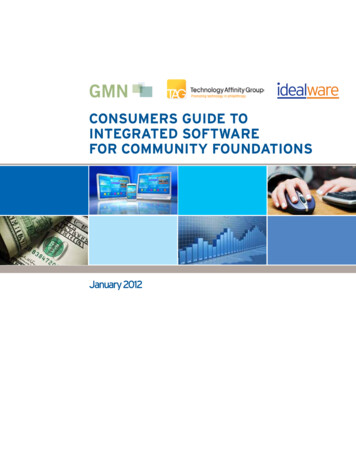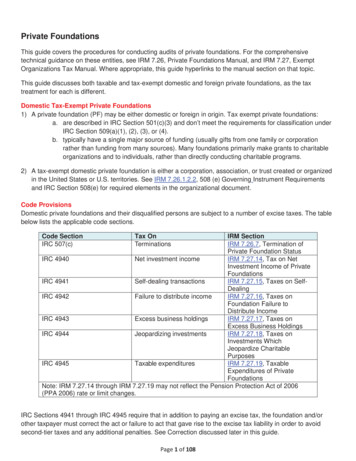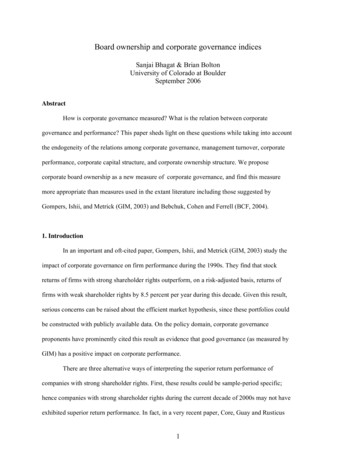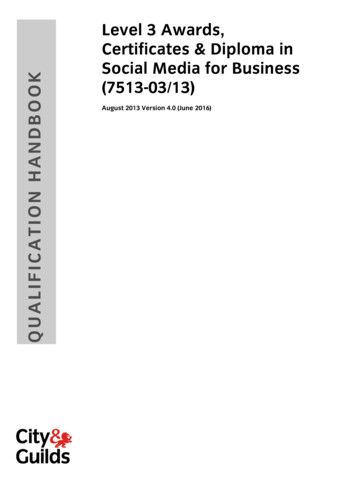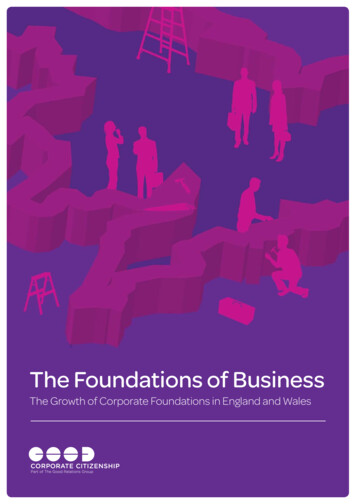
Transcription
The Foundations of BusinessThe Growth of Corporate Foundations in England and WalesThe Foundations of Business – The Growth of Corporate Foundations in England and Wales January 2013 Corporate CitizenshipPage 1
Page 2 Corporate Citizenship January 2013 The Foundations of Business – The Growth of Corporate Foundations in England and Wales
ContentsExecutive summary.2Foreword.3What do we mean by a foundation?.4Methodology.5Changing dynamics since 2006.6Discussion – the surprising growth. 11International comparisons.12Thinking of setting up a corporate foundation?.13The Foundations of Business – The Growth of Corporate Foundations in England and Wales January 2013 Corporate CitizenshipPage 1
Executive summaryBusinesses continue to tell their stakeholders that theyare committed to “embedding” responsible practicesinto their companies. They want to avoid the accusationthat corporate responsibility is a separate, bolt-on andinstead present it as a core part of the organisation’sDNA.But corporate foundations are growing in number. Thesedistinct legal entities contribute to community causes ona company’s behalf. They are the effective ‘outsourcing’of community contributions through an arms-lengthbody that is technically independent.This report examines the apparent paradox. We setout to update research from 2006 and 2007 andunderstand if corporate foundations were still growingin number, and explain why. We used the CharityCommission database, a detailed survey of corporatefoundations and in-depth interviews.Page 2The number of foundations has indeed continuedto grow – we identified 140 corporate foundations inEngland and Wales, including around 33 that had beenestablished since 2006.The financial services sector dominates the sectorranking in terms of quantity and income, but most newfoundations have been set-up by a sector that did notpreviously feature in our studies - clothing retailers.Despite their legally separate status, many corporatefoundations are quite integrated with the foundingbusiness and leveraging the benefits that this brings.Our study found that: the giving strategy is often linkedto the company; the majority provide volunteeringopportunities for employees; and an overwhelmingmajority have some senior management involvement.We conclude by discussing the reasons why corporatefoundations continue to grow. Businesses areharnessing the opportunities for innovation, volunteeringand reputation-building to ensure that corporatefoundations, whilst legally separate, create value not justfor society but also for the founding company Corporate Citizenship January 2013 The Foundations of Business – The Growth of Corporate Foundations in England and Wales
ForewordCompanies and their foundations have faced a tough environment in recent years. We’veexperienced the worst economic recession in living memory. The consequences of thishave been felt by communities across the world which are facing increased needs such asunemployment, education and social cohesion.Many companies, meanwhile, continue to voice strong support for responsible businesspractices, including playing an active role in their communities. A recent study suggeststhat “the integration of sustainability into core business practices” is the biggest leadershipchallenge facing global corporates today 1.Stakeholders expect companies to not just talk about responsibility, but demonstratethrough their actions that being good corporate citizens is part of everyday activity.All this might lead us to expect that corporate foundations – the separate, ‘outsourced’ partner of the company –would be fast going out of fashion. Critics have alleged that they can be a PR-fuelled distraction from the real needto make businesses more responsible 2.Our research set out to answer three key questions. Firstly, has the number of corporate foundations increased inrecent years? If so, why? And finally, how has the dynamic between the founding company and the charity changed?The report builds on our previous research in this area. In 2006, we published Revealing the Foundations which,with the help of an advisory group3, defined and estimated the number of corporate foundations in Englandand Wales for the first time. In 2007, we published The Changing Nature of Corporate Responsibility – whatrole for corporate foundations? This study mapped out the changing relationship with corporate responsibilityprogrammes through a series of in-depth interviews.Our latest report provides an update to those findings, and in particular looks at how governance structures andimpact assessment frameworks are operating today, as well as some of the recent trends in income levels.It forms part of a programme of work with corporate foundations and we hope it will contribute to a debate aboutthe valuable role that they can play.Amanda Jordan OBECo-founding Director, Corporate Citizenship1State of Sustainable Business, Globescan with BSR, October 20122For example, see Jonathan Glennie from the Overseas Development Institute: The Charity Disparity, Poverty Matter Blog, The Guardian, 16 January 2012The 2006 Advisory group included representatives from The Cabinet Office, CAF, Camelot Foundation, Abbey Charitable Trust, Vodafone (UK) Foundation,Business in the Community3The Foundations of Business – The Growth of Corporate Foundations in England and Wales January 2013 Corporate CitizenshipPage 3
What do we mean by a foundation?Corporate foundations can take many different forms;indeed, their diversity is part of what makes the sector sodynamic and intriguing.There is no definitive definition of a corporatefoundation. For this research, we have adopted thedefinition that we set out in our initial study from 2006.With guidance from our expert advisory group, thisdefined a “corporate foundation” as:“Charities currently registered in England and Walesby the Charity Commission, whose primary income isderived in some way from a corporate source”.Some corporate foundations retain close links with theirfounding company. Others are much more independentIndependent foundations have trusteeswho are not employees of the company,staff are independent and there is minimalsenior management involvement. Thereis typically a committed funding formulain place, meaning that the foundingcompany donates a fixed sum each year(such as a proportion of profits). Thisset-up tries to ensure that the foundationcan act independently. The focus of givingis not normally linked to, or guided by, thebusiness. Volunteering opportunities forcompany employees are often rare.Page 4and separate – in terms of staff, their physical location,financial resourcing and management approach.In our original research, drawing on work by Business inthe Community (2003), we put forward a frameworkfor thinking about their different levels of operationalindependence.By law, corporate foundations must be legally separate fromtheir founding corporations. However, we posited that thedegree of separation varied quite significantly in practice.We identified two categories on a spectrum of operational structures. As part of this new study, we haveasked corporate foundations to classify where on thisspectrum they find themselves:Integrated foundations have companyemployees as trustees and high levelsof senior management involvement;staff are seconded from the business.They typically do not have a committedfunding formula, meaning that they aredependent upon contributions from thecompany, and this may vary from yearto year. The giving strategy is typicallylinked to the business strategy or locality.Volunteering opportunities for companyemployees are a core part of thefoundation’s activities. Corporate Citizenship January 2013 The Foundations of Business – The Growth of Corporate Foundations in England and Wales
MethodologyOur research began by updating the list of corporatefoundations that we first identified in 2006. We usedthe Charity Commission’s database to search for newcorporate foundations that identifiably matched ourdefinition. This is not an exact science: identifying afounding corporation is not always obvious, and ourdefinition necessarily entails some grey areas. Forexample, football clubs that establish foundations are,according to our definition, corporate foundations asthey are normally established by a trading business.Conversely, a foundation established by a successfulentrepreneur acting independently from their companywould fall outside of the scope of our research.We developed an online survey to quantitatively testa number of the emerging ideas. This was sent to allfoundations for which we had an identifiable contact oremail address and achieved a response rate of 18%.Finally, we undertook a small number of in-depthinterviews to explore the changing dynamics inthe sector. We are grateful to Thomas Jelley fromthe Sodexo Foundation, David Emerson from theAssociation of Charitable Foundations (ACF) and theACF network of corporation foundations, chaired by PamWebb of Zurich Community Trust, for taking the time tocontribute their thoughts.The analysis was undertaken between July and October2012, using the latest information available on the CharityCommission website. Accounting periods vary; datareferred to in this report as 2011 covers the financial year2010-11 for some foundations.The Foundations of Business – The Growth of Corporate Foundations in England and Wales January 2013 Corporate CitizenshipPage 5
Changing dynamics since 2006Number of foundationsOur research identified 140 corporate foundations,according to our definition, from records held by theCharity Commission in England and Wales.This is an overall increase on the 126 that we identifiedin 2006. In total, we identified 33 new foundations thathad been established since our original study– a strongrate of growth averaging over five per year. Twofoundations which were not previously identifiedwere added to the list.The overall increase is consistent with our previousresearch. This suggested that the number had beenrising steadily since the 1960s. In total, the 2000s sawaround 40 new corporate foundations established. Inthe 2010s so far, 13 new corporate foundations havebeen established and registered. This rapid rate ofgrowth, if sustained, looks set to make the 2010s oneof the most intense periods of establishing corporatefoundations. However, the 1990s still stands out as theperiod of the highest levels of set-up activity, largely dueto de-mutualisations.Figure 1: Number of corporate foundations that exist today, by decade of establishment5043454040353024252015109131150Pre 1970s1970s1980sOur research also found that around 21 corporatefoundations that existed six years ago are no longerregistered today.Page 61990s2000s2012sThe reasons for their disappearance are wide ranging,including the merging of two separate foundationsinto one. Corporate Citizenship January 2013 The Foundations of Business – The Growth of Corporate Foundations in England and Wales
Foundations by sectorFinancial services continues to be the sector with themost corporate foundations. This sector has grownin recent years. Additions include the Credit SuisseEMEA Foundation (established 2008) and the ApaxFoundation (2006).However, in terms of new foundations, financial servicesrank second to clothing retailers. This is a new groupingthat was not prominent in our earlier research. Recentarrivals include the Burberry Foundation (2008);Primark Better Lives Foundation (2008); White StuffFoundation (2010); and Jimmy Choo Foundation (2011).Figure 2: Corporate Foundations by e-2006OtherPost-2006Motor vehiclesMedia and productionFootball clubFood and beverageFinancial servicesExtractivesConsumer goodsConstructionClothing retailerAirlines and airports051015202530354045Motivations for setting up a foundationOur survey revealed that the reasons for setting upnew foundations were varied. Of those which hadbeen established since July 2006, the reasons citedincluded providing more focus and structure to giving,and “promoting the values” of the company in a noncommercial environment.From a reputation-building point of view, the stronggrowth in foundations from the financial services sectoris not surprising. Many companies have been rocked byhigh degrees of scrutiny in recent years and some mayhave sought to ‘give something back’ more prominentlyto the community through a foundation.Conversely, clothing retailers are likely to have differentmotivations, three examples of which are shown in thebox.The Foundations of Business – The Growth of Corporate Foundations in England and Wales January 2013 Corporate CitizenshipPage 7
The Jimmy Choo Foundation was launched in 2011, byTamara Mellon, in conjunction with the company’s 15thAnniversary. It was established to fund and implementprojects designed to empower women. The foundationworks on the basis that women’s empowerment hasactual as well as moral benefits. It helps raise economicproductivity, reduce infant mortality, improve health andnutrition and increase the chance of education for the nextgeneration: ‘Progress is achieved through women’. Theagenda for empowering women through the foundationfocuses on addressing abuses that afflict women globally:sex trafficking and forced prostitution; gender-basedviolence; maternal health; and building confidenceand independence through education and economicopportunity.White Stuff Foundation was set up in 2010 and focuseson supporting disadvantaged children and young peoplein local communities. It is supported by White Stuff, whichhas committed to giving at least 1% of its annual profits tothe foundation. All White Stuff shops are partnered withtheir own local charity. The foundation gives regular grantsThe reality is that companies have many and variedmotives for setting up a foundation. For some, thereare reputational benefits; for others, a more structuredand independent approach to community giving isto these charities in addition to funds raised by staff andcustomers. It aids disadvantaged children and youngpeople by helping them to “realise their true potential andto support their health and well-being”. The foundation iscurrently supporting over 84 charities across the UK, two inDenmark and two in India.The Burberry Foundation was set up by ChristopherBailey and Angela Ahrendts in 2008 as a ‘philanthropicorganisation dedicated to helping young people realisetheir dreams and potential through the power of theircreativity’. The foundation is funded by donations fromBurberry, its employees and customers and works throughgranting financial support to innovative programmesas well as developing sustainable partnerships withcharitable organisations that work with young people. Thefoundation also provides a strategic platform for Burberry’sengagement in community initiatives and builds charitablegiving in regions where the majority of Burberry employeeslive and work. The three key components which theBurberry Foundation seeks to foster through its giving are:confidence, connection, and opportunity.the logical next step on their corporate responsibilityjourney. Often, this is linked to an anniversary, providingan enduring legacy for the foundation.Levels of operational independenceOur survey shed new light on the current set-up ofcorporate foundations. We tested a series of statementsto unpick where foundations find themselves on thespectrum from ‘integrated’ to ‘independent’.Overall, the findings indicate that most corporatefoundations are relatively integrated with the foundingcompany: Nearly 90% of respondents indicated that there wasat least some “senior management involvement” fromthe company. Most foundations (84%) appear to have at least onetrustee who is an employee of the donor company. Nearly three quarters (73%) of respondents indicatedthat some foundation staff are seconded from thebusiness. Only one in five described this statement as“not at all accurate”. A majority (58%) of respondents described thestatement that “the giving strategy is linked to thebusiness focus” as accurate. A third said it was “notvery accurate” and only one in ten described this as“not at all accurate”.Page 8 58% indicated that there was “a link to employeevolunteering” – slightly lower than other measures ofintegration, but still a majority.Overall, it appears that most corporate foundations aresomewhat integrated with the founding company.There are clear benefits that this can bring to boththe foundation and the business beyond thoseof merely sharing management and operationalresources. This interconnectedness means that thestrategy of the foundation is often linked to that of thefounding business, most are able to offer volunteeringopportunities to company employees and seniormanagement involvement is prominent.Some companies now view their foundations as poolsof innovation. By seeding them with the right people,ideas, resources, technologies and business acumen,these companies are seeking to improve their ability tomeet societal needs in the long-term. This is an excitingopportunity which helps to further differentiate thecorporate model from mainstream foundations. Corporate Citizenship January 2013 The Foundations of Business – The Growth of Corporate Foundations in England and Wales
Legal structureThere are two legal mechanisms for a corporatefoundation – a trust, or a company limited by guarantee.Of the corporate foundations that we identified,around a third were registered as a company limited byguarantee and the majority were by Trust Deed. This isconsistent with the breakdown of our previous findings.Sources of incomeAll of the foundations identified in our research receivea substantial proportion of their income from theirfounding companies.There also appears to be a high level of variation in theformal funding arrangements. Many indicated that therewas an annual promise or deed of covenant. Othersindicated that the funding was more periodic in nature.However, the income spread is varied: Over half the foundations that participated in oursurvey received over 70% of their income in companydonations. For one in five foundations, company donations madeup all of their income.Of all the respondents to our survey, the majority (68%)said that they did not have a committed funding formulain place. Of the remainder that did, around half of theseindicated that it was a fixed percentage of companyprofits; the others had a more flexible arrangement, suchas a minimum guarantee or in-kind support. One in ten of the foundations said that they relyentirely on investments for their income.Levels of incomeWe studied the latest financial figures for each corporatefoundation that had been filed with the CharityCommission by July 2012. Accounting periods vary and notall charities had registered files for the latest time period. Forthis reason, we also analysed the data from 2010 in orderto make valid comparisons with our earlier study. Averagesare used for comparison as not all foundations had recordsavailable, and the total sample sizes differed.The average income of corporate foundations appearsto have fallen in recent years. The average recorded income fell from 1.75m in 2005to 1.68 million in 2010. Although not all foundations had figures for 2011, theavailable data suggests a further fall in average incometo 1.46 million – a 16.5% fall over six years. Some large players had not yet filed accounts; manythat had done so did record an increase on theprevious year. But others have seen dramatic falls,such as the Northern Rock Foundation, whoseincome fell from 15.17m in 2010 to 339,000 in 2011. Despite the average fall, Lloyds TSB Foundationovertook the Vodafone Group Foundation as thelargest in our group, with an income of 25.9 millionin 2011.Expenditure and donationsWhilst income has fallen, the average amount spent bycorporate foundations has risen over the same time period: Average expenditure has risen by around 14% from 1.42 million in 2005 to 1.62 million in 2011. In terms of donations, there also appears to have beenan increase. The figures show a rise in the averageamount that foundations donated from 1.34 million in2005 to 1.86 million in 2011. This means that totalling up all corporate foundations,the average expenditure and donations are nowgreater than average income. This is because a smallnumber of larger foundations gave away more thanthey received in income in recent years.The Foundations of Business – The Growth of Corporate Foundations in England and Wales January 2013 Corporate CitizenshipPage 9
Impact of the Recessionsociety. In recent years the Trust has had to alter its patternof contributions, as the following extract from their 2011annual report shows: “Man’s charitable contribution isbased on the financial performance of the business. As aresult of lower performance fees Man donated 1.5 millionin the period ( 3.8 million in the year ended 31 March 2011)to the Trust and charitable committees of our overseasoffices”. The company also reveals that “with less fundingavailable we narrowed our focus to support those charitiesworking with the most excluded and disadvantaged, suchas supporting the homeless or long-term unemployedinto education, training or employment. The Trust builtup its reserves in 2009 in order to ensure we were able tomaintain a consistent level of giving and therefore donated 3.8 million in this period to support charities when theyneeded it the most.”As our survey reveals, a large number of foundations arereliant on founding companies for their income. It perhapstherefore comes as no surprise that income has reducedduring the tough economic environment that manycompanies have experienced since 2007.Our interviewees suggested that the recession has hadmixed impacts on corporate foundations. For some, theneed to “do good and help others” was as acute as ever,whilst we identified elements of greater corporate control,restrictions on funding and requirements to prove impactsfrom others.Man Group Charitable Trust, founded in 1978, providesone example. It gives grants to charitable organisationsthat help transform the lives of the disadvantaged in ourCauses supportedFoundations continue to support a wide range of causes.Although difficult to quantify into simple categories, ourresearch suggested that economic hardship, young peopleand education continue to be popular themes. Thesetopics are consistent with broader trends in corporatecommunity investment, with the exception of a category ofhealth issues that many companies also support 4 .Around half the respondents to our survey said that“education and young people” was their primary focus.Impact assessmentFinally, we asked respondents to our survey about whetherthey measured the impacts that they created in any way. Astartling 42% of the corporate foundations that respondedstated that “we do not do impact assessment”.indicative of the fact that new foundations have beenset up that have not yet had time to get to grips withthis challenging area. Our survey found that thosefoundations which were recently established weresignificantly more likely to indicate that they did not doimpact assessment than the more established ones.This poses questions around how foundations areable to accurately judge their performance. It may beFigure 3: On a scale from 1 to 10, how accurate do you think your impact assessment is?%4542%40353025201510504We do not 1: not at allimpactaccurateassessment2345678910: veryaccurateDon’tknowLBG – The Global Standard for Measuring Corporate Community Investment, 2012 Annual ReviewPage 10 Corporate Citizenship January 2013 The Foundations of Business – The Growth of Corporate Foundations in England and Wales
Discussion – The surprising growthAt first sight, the continued growth in corporate foundationsmay come as a surprise. As previously mentioned, theemphasis on embedding corporate responsibility as well asthe financial pressures being placed on companies shouldpoint in the opposite direction.Yet it is clear that corporate foundations serve a valuablefunction. Our interviewees, as well as our own experienceof working with foundations, suggest a number ofbenefits.Corporate foundations permit the founding companyto ‘ring fence’ and protect its community contributions.They enable a degree of independence and autonomy,though as our findings reveal, real independence is rarein reality.Increasingly, they are being harnessed as a forumfor innovation to provide employees, often throughvolunteering, with a source of inspiration as well aspersonal development.Finally, they allow the company to point to a publiccommitment, in the domestic market and on the worldstage, to the community. Foundations have becomepart of a global language and as we see increasedglobalisation, this is undoubtedly a key driver in theirdevelopment.For these reasons, the intensely close relationshipbetween the corporate foundation and its foundingcompany should come as no surprise. Having providedthe funding for the set-up, and with such clear benefitsavailable, many businesses want to retain a close workingrelationship.The data shows that the average income of corporatefoundations has fallen in recent years. Yet donationsand total expenditure appear to be up, on average. Thismay reflect the fact that there is no shortage of worthycauses: the prevalence of young people and economichardship amongst the causes supported suggests this.But the lack of impact assessment indicates thatmany foundations are spending money without fullyunderstanding what benefits they are creating.This could be indicative of the dynamism and infancy ofthe sector, with new foundations not yet having set upall their processes. Alternatively, it could show a worryinglack of concern for being able to measure and report onthe impacts that projects are creating.This goes to the heart of the question of whether afoundation is simply a grant-giving body or part of astrategic approach by the company to communityinvestment. If companies invest their time, energy andfinancial resources in setting up a corporate foundation,then understanding the impacts that this creates mustbe critical to its evaluation.Despite the challenging times, foundations have enduredand continued to grow. In the coming decade, we canexpect more corporates to embark on this journey,enabling the sector to continue to play a valuable role inour society.The Foundations of Business – The Growth of Corporate Foundations in England and Wales January 2013 Corporate CitizenshipPage 11
International comparisonsThis report focuses on corporate foundations in Englandand Wales. However, a comparison with internationalfoundations shows that the growth experienced inEngland and Wales appears typical of Europe. Inaddition, the close integration with founding companiesis an enduring characteristic of the sector in othercountries.FranceOne of the most interesting features of the Frenchexperience is that corporate foundations in Francefall under a well-developed legal framework, with eightdifferent forms of foundation specified that range from‘endowment funds’ to ‘partnership foundations’. This isnot the case in the UK where corporate foundations arenot separately classified. Yet there are similarities: someof the most popular areas of action for foundations areeducation and social action, with 52% of foundationssupporting projects for young people in France. The levelof integration between foundations and their corporatepartners is also similarly high, with 52% of corporatefoundations stating that their main purpose is linkedwith the company’s activity, which is deemed to beconsistent with their “public interest” test. At the endof 2011, there were 450 corporate foundations inFrance, with around half of these created in the pastfive years (Research from the IMS-Entreprendre pourla Cité, 2012).GermanyThere is no clear definition of a corporate foundation inGermany. However, one study has estimated that around450 foundations can be classified as such, in additionPage 12to around 670 corporate foundations of saving banks(Sparkassen-Stiflungen). Nearly all major corporationsthat are publicly listed have established at least onecorporate foundation, with a boom in the creation ofcorporate foundations in the last 20 years. Germancorporate foundations have both higher assets, andhigher expenditures than other charitable foundations inthe country, with 43% of corporate foundations spendingmore than 100,000 per year. As in France and theUK, education is a popul
foundations have been set-up by a sector that did not previously feature in our studies - clothing retailers. Despite their legally separate status, many corporate foundations are quite integrated with the founding business and leveraging the benefits that this brings. Our study found that: the giving strategy is often linked




